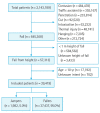Characteristics of fall-from-height patients: a retrospective comparison of jumpers and fallers using a multi-institutional registry
- PMID: 38018072
- PMCID: PMC11009701
- DOI: 10.15441/ceem.23.074
Characteristics of fall-from-height patients: a retrospective comparison of jumpers and fallers using a multi-institutional registry
Abstract
Objective: Fall from height (FFH) is a major public health problem that can result in severe injury, disability, and death. This study investigated how the characteristics of jumpers and fallers differ.
Methods: This was a retrospective study of FFH patients enrolled in an Emergency Department-based Injury In-depth Surveillance (EDIIS) registry between 2011 and 2018. Depending on whether the injury was intentional, FFH patients who had fallen from a height of at least 1 m were divided into two groups: jumpers and fallers. Patient characteristics, organ damage, and death were compared between the two groups, and factors that significantly affected death were identified using multivariable logistic analysis.
Results: Among 39,419 patients, 1,982 (5.0%) were jumpers. Of the jumpers, 977 (49.3%) were male, while 30,643 (81.9%) of fallers were male. The jumper group had the highest number of individuals in their 20s, with the number decreasing as age increased. In contrast, the number of individuals in the faller group rose until reaching their 50s, after which it declined. More thoracoabdominal, spinal, and brain injuries were found in jumpers. The in-hospital mortality of jumpers and fallers was 832 (42.0%) and 1,268 (3.4%), respectively. Intentionality was a predictor of in-hospital mortality, along with sex, age, and fall height, with an odds ratio of 7.895 (95% confidence interval, 6.746-9.240).
Conclusion: Jumpers and fallers have different epidemiological characteristics, and jumpers experienced a higher degree of injury and mortality than fallers. Differentiated prevention and treatment strategies are needed for jumpers and fallers to reduce mortality in FFH patients.
Keywords: Accidental falls; Suicide; Suicide prevention; Wounds and injuries.
Conflict of interest statement
The authors have are no conflicts of interest to declare.
Figures
References
-
- World Health Organization (WHO) WHO; 2021. Fact sheets: falls [Internet] [cited 2021 Aug 19]. Available from: https://www.who.int/news-room/fact-sheets/detail/falls.
-
- Korean Statistical Information Service (KOSIS) Statistics Korea; Causes of death statistics 2011-2017 [Internet] [cited 2018 Sep 19]. Available from: https://kosis.kr/eng/
-
- Ministry of Health and Welfare. Korea Foundation for Suicide Prevention . 2022 White paper on suicide prevention. Korea Foundation for Suicide Prevention; 2022.
-
- Younis MS, Lafta RK. Suicide and suicidality in Iraq: a systematic review. Med Confl Surviv. 2023;39:48–62. - PubMed
Grants and funding
LinkOut - more resources
Full Text Sources




